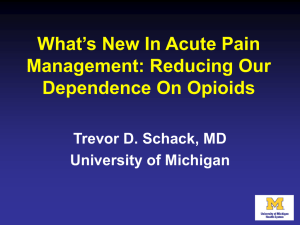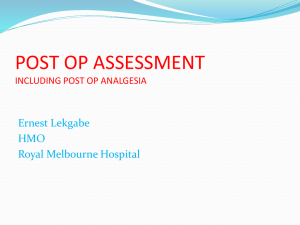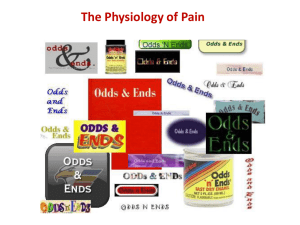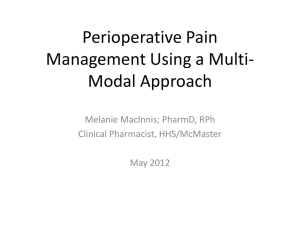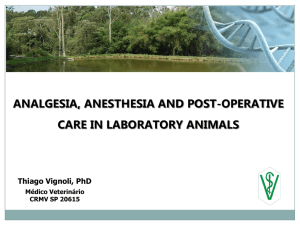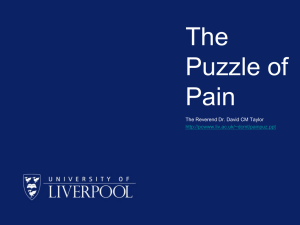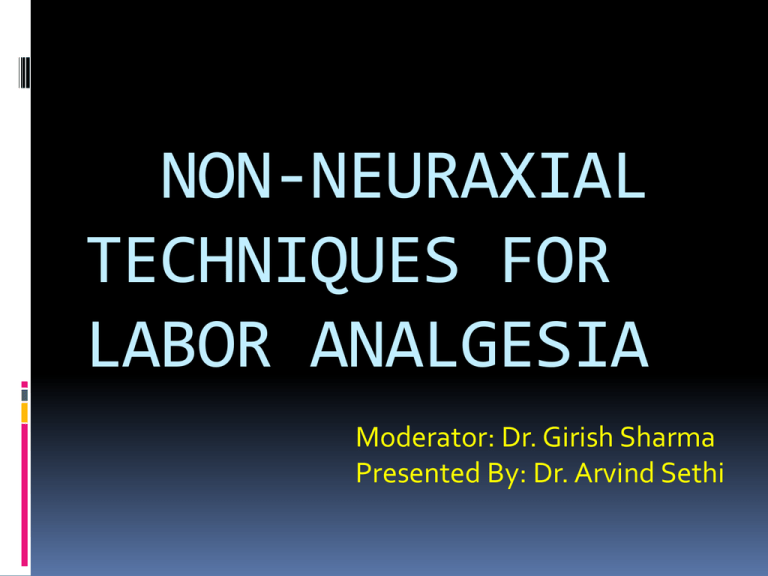
NON-NEURAXIAL
TECHNIQUES FOR
LABOR ANALGESIA
Moderator: Dr. Girish Sharma
Presented By: Dr. Arvind Sethi
INTRODUCTION
labor pain is one of the most intense pain a
women can experience.Efforts have been taken for
centuries to remove the labor pain, but it has never
been easy in the past as it is in the present. While
neuraxial analgesia is the gold standard for
achieving complete analgesia in labor, many
women do not desire such high-tech pain relief.
Many women want to ‘Cope with pain of labor ‘
rather than anhilate the pain completely. For many
of these women non-neuraxial techniques will
suffice.
The Physiology of Pain in Labor
1st stage of labor – mostly
visceral
Dilation of the cervix and
distention of the lower uterine
segment
Dull, aching and poorly localized
Slow conducting, visceral C fibers,
enter spinal cord at T10 to L1
2nd stage of labor – mostly somatic
Distention of the pelvic floor,
vagina and perineum
Sharp, severe and well localized
Rapidly conducting A-delta fibers,
enter spinal cord at S2 to S4
T10
L1
S2
S4
http://www.manbit.com/oa/oaindex.htm
The Intensity of Pain in Labor
http://www.manbit.com/oa/oaindex.htm
NON-NEURAXIAL LABOR ANALGESIA
Pharmacological
Non-Pharmacological
Systemic analgesia
Parenteral
Inhalational
Techniques' alternative to
regional anesthesia
Paracervical block
Pudendal block
Minimal Training/Equipment
Continuous labor support
Touch and massage
Therapeutic use of heat and cold
Hydrotherapy
Vertical position
Specialized Training/Equipment
Intradermal water injections
Transcutaneous Electrical Nerve
Stimulation
Acupuncture/Acupressure
Hypnosis
Parenteral opioid analgesia
opioid are the most widely used systemic
medications for labor analgesia.
Their use does not require specialised equipment or
personnel.
Allows the parturient to better tolerate the pain of
labor.
Little scientific evidence suggests that one drug is
better than other.
Selection of an opioid is based on institutional
tradition/personnel preference
Efficacy and incidence of side effects are largely
dose dependent rather than drug dependent
Analgesia (contd)
Although narcotics provide both analgesia &
sedation, their S.E are:
1. Maternal: Orthostatic hypotension, nausea,
vomiting ,delayed gastric
emptying,dysphoria,drowsiness,hypoventila
tion.
2. Fetal: ↓ beat-to-beat variability of FHR.
3. Neonatal: respiratory depression ,
neurobehavioral changes.
7
Systemic opioids for labor
DRUG
Usual
Onset
Duration Comment
analgesia
dose
s
Meperidine
25-50mg IV
50-100mg
IM
5-10min IV
40-45min IM
2-3 hrs
Morphine
2-5mg IV
5-10mg IM
3-5min IV
20-40min IM
3-4 hrs
More neonatal
depression than
meperidine
Diamorphin
e
5-7.5mg
IV/IM
5-10min IM
90 min
More euphoria,
less nausea than
morphine
Fentanyl
25-50ùg IV
100úg IM
2-3min IV
10min IM
30-60min
Less neonatal
depresion than
with meperidine
Max. neonatal
depression 1-4
hrs after the
dose
Systemic analgesia contd.
Nalbuphine 10-20mg
IV/IM
2-3 min
IV/IM
3-6 hrs
Lower neonatal
neurobehaviora
l scores
Butorphano 1-2mg IV/IM 5-10min IV 3-4hrs
l
10-30min IM
Ceiling effect on
respiratory
depression
Meptazinol
100mg IM
15 minIM
2-3 hrs
Less sedation &
respiratory
depression
Pentazocine 20-40 mg
IV/IM
2-3min IV
5-20min
IM/SC
2-3 hrs
Psychomimetic
effects possible
Tramadol
10 min IV
2-3 hrs
Less efficacy &
more side
effects than
meperidine
50-100mg
IV/IM
Intermittent Bolus Parenteral
opioid Analgesia
Given intermitently via s.c ,i.m, i.v
route(preferred)
Faster onset of analgesia
Ability to titrate dose to effect
MEPERIDINE
Most commonly used opioid for labor analgesia
100 mg i.m repeated once after 4 hrs
Onset ;45 min
Readily crosses placenta by passive diffusion & equilibrates
b/w maternal and fetal compartments in 6 minutes
Fetal exposure to meperidine is highest b/w 2-3 hrs after
maternal administration(more respiratory depression in
neonates born within 2-3 hrs)
Causes less respiratory depression in neonate than
morphine
Metabolised in liver to normeperidine which crosses the
placenta & is also formed as a result of fetal and neonatal
metabolism( half life = 60 hrs in neonate)
Meperidine contd.
Effect on progress of labor is contentious
Some obstetricians say that it may prolong
the latent phase of labor, others administer it
to shorten the length of first stage in cases of
dystocia
Sosa et al. concluded that meperidine does
not benefit women & should not be used in
labor with dystocia because of adverse
neonatal outcome
MORPHINE
Currently morphine is infrequently prescribed in
labor
Significant analgesic but respiratory depressant
Rapidly crosses the placenta and a fetal to maternal
plasma conc. ratio of .96 is observed at 5 min.
Elimination half life is longer in neonates than in
adults
Crosses BBB more in fetus
Greater plasma clearance, shorter elimination half
life, earlier peak metabolite levels occur due to
changes in pharmacokinetics during pregnancy
Diamorphine
A synthetic derivative of morphine
Rapid, effective analgesia with less nausea &
vomiting but more euphoria than morphine
Crosses placenta & associated with respiratory
depression
FENTANYL
Synthetic opioid with analgesic potency
100 times that of morphine
800 times that of meperidine
Rapid onset, short duration of action, lack of active
metabolite make it attractive for labor analgesia
Average umbilical –to-maternal conc. ratio remains
low at 0.31
The researchers found less sedation, vomiting,no
adverse effect on APGAR score or fetal acid-base
status
NALBUPHINE
Mixed agonist-antagonist opioid analgesic
Potency and respiratory depression are similar with
morphine at equianalgesic dose
Ceiling effect on respiratory depression with
increasing dose(max. with 30mg dose)
Mean umbilical vein-t0-maternal conc. ratio is higher
with nalbuphine than with meperidine
less nausea, vomiting but more maternal sedation
than meperidine
BUT0RPHANOL
opioid with agonist-antagonist properties
5 times as potent as morphine & 40 times as potent
as meperidine
Respiratory depression with
butorphanol , morphine,meperidine
(2mg) =
(10mg)
(70mg)
(4mg) <
(20mg)
(140mg)
Butorphanol(1-2mg) when compared with
meperidine(40-80mg) for labor analgesia , it has
less maternal side effects, better analgesia at 30min
and 1 hour with no difference in APGAR score.
Butorphanol(cont.)
Butorphanol offers analgesia with some
sedation( similar to meperidine+
phenothiazine)
Shorter half life and inactive metabolite.
Favorable neonatal neurobehavioral outcome
A USEFUL AGENT FOR LABOR ANALGESIA
MEPTAZINOL
Partial opioid agonist with less sedation, resp.
depression, dependence
Neonatal half life =3.4 hrs
Higher APGAR score at 1min
Limitations; Higher Cost & Availability
PENTAZOCINE
Synthetic opioid , both agonist and weak
antagonist
30-60mg equipotent as 10mg morphine
Ceiling effect on respiratory depression occurs at
40-60mg
Limitation ;Psycho mimetic effect at higher doses
TRAMADOL
Atypical, weak synthetic opioid
Potency 10% that of morphine
No respiratory depression
More nausea
Analgesia not superior to meperidine
PROGRAMMED LABOR
(Modern management of labor)
Criteria for selection of cases
Gestational age of 37- 42 weeks
Cervical dilatation ≥ 4cm
Cervical status: bishop score >6
Engaged head & adequate pelvis
No pregnancy induced complication like APH
or medical disorders like Heart disease, DM,
HTN, Jaundice.
Programmed labor(contd.)
Labor is programmed in the following way
When the case is in active phase i.e. os ≥ 4cm
1) LR (500ml) with 2.5U oxytocin started such that contractions
≥3 per 10min lasting for 20-40 sec.
2) ARM done.
3) 2mg of diazepam (1ml) & 6mg of pentazocine(2ml) diluted
with 7ml of normal saline, so that total solution is 10ml. Total
2ml of the solution is given slow iv. Remaining 8ml added to
iv fluid post-partum during repair of tear or episiotomy.
4) Inj. drotaverine & tramadol given i.v. and repeated as
required.
5) Partographic management of labor is done
Active management of labor with oxytocin,
amniotomy and spasmolytic and labor analgesia
with tramadol,diazepam & pentazocine is safe,
convenient and acceptable.
Marked labor analgesia.
There is marked reduction of the total duration
of labor.
Marked in LSCS rate.
Minimum side effects on mother.
No effect on of apgar score of fetus
PATIENT CONTROLLED ANESTHESIA
Patient-controlled analgesia (PCA) is commonly assumed
to imply on-demand, intermittent, IV administration of
opioid under patient control (with or without a continuous
background infusion).
This technique is based on the use of a sophisticated
microprocessor-controlled infusion pump that delivers a
pre-programmed dose of opioid when the patient pushes
a demand button
Besides i.v., alternative routes for PCA delivery are
s.c.,
oral,transmucosal,nasal,intrathecal,epidural,transdermal
PCA has several modes of administration.
Most common ;
1) demand dosing (a fixed-size dose is self-administered intermittently)
2) continuous infusion plus demand dosing (a constant-rate fixed
background infusion is supplemented by patient demand dosing)
All modern PCA devices offer both modes.
Less common
1)Infusion demand ( successful demands are administered as an infusion)
2) preprogrammed variable-rate infusion plus demand dosing ( the
infusion rate is preprogrammed on an interval clock to vary or turn off
altogether by time of day)
3) variable-rate feedback infusion plus demand dosing
(microprocessor monitors demands and controls the infusion rate accordingly) .
Advantages of PCA
Superior pain relief with lower doses of drug
Less risk of maternal respiratory depression
Less placental transfer of drug
Less need for anti-emetic agents
Higher patient satisfaction
Limitations
Despite frequent administration, small doses
of opioid may not be effective for fluctuating
intensity of labor pain
Risk to fetus & neonate remains unclear
Variable doses & lockout intervals have been
used
Most appropriate drug, dose ,dosing schedule
have not been defined
opioid USED FOR PCA
Patient
Controlled Dose
Lockout interval
Meperidine
10-15mg
8-20min
Nalbuphine
1-3mg
6-10min
Fentanyl
10-25úg
5-12min
DRUG
Remifentanil
(bolus)
0.4-0.5úg/kg
Infusion rate
(background infusion 0.05úg/kg/min
Bolus;0.25úg/kg
2-3min
INHALATIONAL ANALGESIA
PRINCIPLE
An attractive option since pregnancy causes
decreased FRC
increased minute ventilation
Rapid equilibration b/w inspired and alveolar conc.of
inhaled agent
Features of inhalational agent that make it suitable for
labor analgesia are related to
1) Nature of labor pain: pain is felt 10-20 sec. after
onset of uterine contraction & lasts for 40-60 sec.
2) Blood gas solubility: low inhalation at onset of
contraction results in analgesic blood levels which
rapidly falls out at the end of contraction
INHALATIONAL ANALGESIA
ENTONOX: NITROUS OXIDE(50%)+ OXYGEN(50%)
Provides partial pain relief during labor as well as at delivery.
50% N2O in O2.(Pre-mixed in a blender)Poynting effect involves
dissolution of gaseous O2 bubbled through liquid N2O with
vaporization of liquid to form gaseous mixture.
It’s administered with a mask / mouthpiece in a manner such
that the parturient remains awake, cooperative & in control of
her airway to prevent pulmonary aspiration of gastric
contents.
Does not prolong labor or interfere with uterine contractions
but administration > 20 minutes may result in neonatal
depression.
Dec. risk of neonatal depression when compared with narcotics.
31
Instruct pt. to inhale deep in b/w the contraction
Inhale 30 sec. before the next anticipated
contraction & cease with receding of contraction
In b/w mask may be removed which is held by pt.
Inform that total relief of pain will not occur but
gas will provide some relief
IV line, pulse oximetry
Methoxyflourane, Enflurane,Isoflurane do not
have any adv. over nitrous oxide
SEVOFLURANE
MOST COMMONLY USED VOLATILE
HALOGENATED AGENT
0.8% sevoflurane is optimal conc. for labor
analgesia
Investigators concluded that sevoflurane can
provide useful analgesia for labor & is superior to
Entonox
Initial studies of intermittent sevoflurane are
promising , but larger studies are needed to assess
the incidence of maternal compromise
Drawover oxford Miniature
vapouriser
PARACERVICAL BLOCK
Provides satisfactory pain relief during first stage
Goal: to block paracervical(Frankenhauser’s)
ganglion which is immediately lateral & posterior to
cervicouterine junction
Does not adversely affects labor
provides good analgesia in first stage without the
annoying sensory & motor blockade
Does not relieve pain during late first stage& second
stage of labor
Technique:
Patient in modified lithotomy position(pillow below
pt.’s right buttock to correct dextrorotation of uterus
Use a needle guide to define & limit the depth of
injection & to reduce the risk of vaginal & fetal injury
Introduce needle & needle guide into left/right lateral
vaginal fornix at 4’0’ clock or 8’0’ clock position (with
left hand for left and right hand for rt. side.
Needle is advanced through vaginal mucosa and to a
depth of 2-3mm
5-10 ml of local anesthetic(without epinephrine) is
injected on each side
Maternal complications
Vasovagal syncope
Lacerations of vaginal mucosa
Systemic local anesthetic toxicity
Parametrial hematoma
Postpartum neuropathy
Paracervical or subgluteal abscess
Fetal Complications
1)Fetal injury from direct injection of LA into fetal
scalp(advanced labor>8cm) leading to systemic
toxicity
2)Fetal Bradycardia in 15% cases because of
drug induced uterine artery vasoconsriction,CNS
depression. myocardial depression
decreased placental perfusion because of uterine
hypertonia as a result of post paracervical block
causing increase in uterine activity
Manipulation of fetal head,uterus,uterine vessels
produce reflex bradycardia
PUDENDAL BLOCK
Goal is to block the pudendal nerve distal to its
formation by the ant. division of S2-S4 but proximal
to its division into branches.
Provide satisfactory anesthesia for vaginal delivery
& outlet forceps application
Administered shortly before delivery
•
Analgesia produced in lower birth canal & perineum
provides maternal comfort for low forceps delivery &
episiotomy.
Advantages: easy to administer, not a/w maternal
hypotension/ fetal distress.
Disadvantage: incomplete analgesia at the time of
delivery, since pain of uterine contraction is
Technique
Transvaginal—preffered
Transperineal
A tubular introducer is placed against vaginal mucosa just
beneath the tip of ischial spine
A 15cm ,22G needle is pushed through introducer 1-1.5cm
beyond the introducer into the mucosa
1ml of 1% lignocaine is injected into mucosa after aspiration
Sacrospinous ligament is infiltrated with 3ml of lignocaine
3ml is injected into loose areolar tissue behind the
sacrospinous ligament
needle is withdrawn into introducer & moved to just above
the ischial spine & rest of 10ml is injected into mucosa
Pudendal block(cont.)
within 3-4 min successful block is achieved(allows
pinching of lower vagina & posterior labia without
pain and loss of anal reflex
COMPLICATIONS
Intravascular injection
Hematoma from perforation of blood vessels
Secondary infection at the injection site which
may spread to hip joint, gluteal muscles.
NON-PHARMACOLOGIC ANALGESIA
Continuous Labor Support
Patient’ sense of isolation adversely affects her
perception of labor.
A meta-analysis evaluated results from 16
studies that included more than 13000 women
who were randomly assigned to receive either
continuous labor support or usual care .Women
who received one-on one support were less likely
to use any type of analgesia & were more likely
to have short labor, spontaneous vaginal delivery
and were better satisfied.
Touch & Massage
Effleurage, Counter pressure to alleviate back
discomfort, light stroking, and merely a reassuring
pat.
Therapeutic use of heat & cold
Warm compresses on localized areas of body
Ice packs on low back or perineum to decrease pain
perception
Hydrotherapy
Simple shower or tub bath or a whirlpool or
large tub specially equipped for pregnant
women.
Decreases anxiety and pain and increases
uterine contraction efficiency
Vertical position
INCLUDE
Sitting, Standing, Walking, Squatting
women reported less pain in vertical
positions than in horizontal
positions(supine,lateral)
Walking neither enhanced nor impaired
active labor & was not harmful to mothers or
their infants.
Intra-dermal Water
Injections
Intra-dermal water injections are used to treat
lower back pain which is a common complaint
during labor
The afferent nerve fibres that innervate the
lower back, enter the spinal cord at T10 through
L1 spinal segments.
Technique: approx. 0.05-0.1 ml of sterile water is
injected intradermally to form a small bleb over
each posterior superior iliac spine on both sides
& at 3cm below & 1cm medial to each spine(Four
injections)
the
injections themselves are acutely painful for
cts
about 20-30 seconds, but as the injection pain
fades. so does the lower back pain.
A simple method of reducing severe low back
pain without adverse effects on mother and
fetus
Transcutaneous Electrical Nerve
Stimulation (TENS)
Involves transmission of low-voltage electrical
current to surface electrodes placed over lower back
in the region of T10-L1
Reduces pain by nociceptive inhibition at a
presynaptic level in dorsal horn by limiting central
transmission.Electrical stimulation activates lowthreshold myelinated nerves.
Afferent inhibition inhibit propogation of
nociception along unmyelinated small “c” fibres by
blocking impulses to target cells in substantia
gelatinosa of the dorsal horn.
TENS also enhances release of endorphins and
dynorphins centrally.
Acupuncture/Acupressure
Four randomized control trials found that pain score
were lower in women randomized assigned to
receive acupuncture treatment, as was the rate of
use of other modes of analgesia. A shorter duration
of the active phase of labor and a reduction in use of
oxytocin in acupuncture group was observed.
Hypnosis
Limitations;
Ante partum training sessions are required.
Trained hypnotherapist must be available during
labor
Offers no clear benefit
Childbirth preparation classes and non-
pharmacologic analgesic techniques are not
comparable with regional analgesia techniques for
relief of labor pains. So whether it is useful for
anesthetist to have knowledge of these techniques?
Our active participation in the childbirth education
classes may help patients receive more accurate
information about the risks and benefits of
analgesia/anesthesia for labor, vaginal delivery. We
can encourage instructors to prepare pt. for the
unexpected as “Typical labor” may infact be atypical.
Thus patients will perceive anesthetist as an integral
part of obstetric team.
THANK YOU


